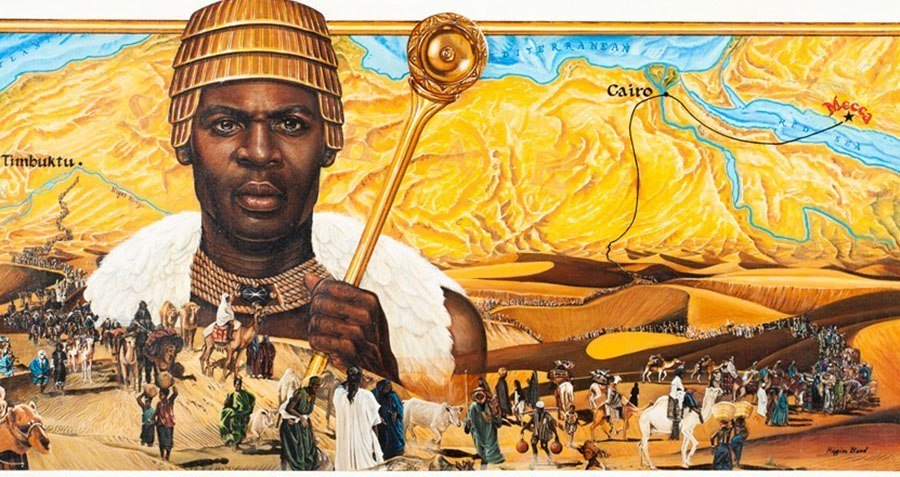Mansa Musa’s estimated Net worth – three times richer than Jeff Bezos!
Just like Wakanda, the resources of the Mali kingdom remained in the dark until Musa set for a spectacular journey to Mecca. The entire world stumbled on the sight of the journey.
He set out with 60000 porters; 6000 slaves carrying Persian silk; 500 slaves bearing gold staff; 80 Camels carrying 140Kg of gold each; Interestingly, when he reached Cairo, he took pity on the people and gifted almost all the gold to the poor he saw. This flooded Cairo with gold and sudden wealth in everyone’s hand caused heavy inflation that lasted more than a decade. Such immense wealth naturally swelled none other from the Mali gold mines.
Mansa Musa was the tenth Mansa (which translates to “sultan”, “conqueror” or “emperor” of the Mali Empire, an Islamic West African state. He has been described as the wealthiest individual of the Middle Ages.
At the time of Musa’s ascension to the throne, Mali in large part consisted of the territory of the former Ghana Empire, which Mali had conquered. The Mali Empire consisted of land that is now part of Mauritania and the modern state of Mali. During his reign, Musa held many titles, such as “Emir of Melle”, “Lord of the Mines of Wangara”, and “Conqueror of Ghanata”.
Mansa Musa conquered 24 cities, along with their surrounding districts. During Musa’s reign, Mali may have been the largest producer of gold in the world, and Musa has been considered one of the richest people in history. However, modern commentators such as Time magazine have concluded that there is no accurate way to quantify Musa’s wealth.
Musa is generally referred to as “Mansa Musa” in Western manuscripts and literature. His name also appears as “Kankou Musa”, “Kankan Musa”, and “Kanku Musa”. Other names used for Musa include “Mali-Koy Kankan Musa”, “Gonga Musa”, and “the Lion of Mali”. He helped his empire reach tremendous growth thanks to encouraging the arts, literature, and architecture.
Musa was a devout Muslim, and his pilgrimage to Mecca made him well known across northern Africa and the Middle East. To Musa, Islam was “an entry into the cultured world of the Eastern Mediterranean”. He would spend much time fostering the growth of the religion within his empire.
Musa made his pilgrimage between 1324 and 1325. His procession reportedly included 60,000 men, all wearing brocade and Persian silk, including 12,000 slaves, who each carried 1.8 kg (4 lb) of gold bars, and heralds dressed in silks, who bore gold staff, organized horses, and handled bags. Musa provided all necessities for the procession, feeding the entire company of men and animals. Those animals included 80 camels which each carried 23–136 kg (50–300 lb) of gold dust. Musa gave the gold to the poor he met along his route. Musa not only gave to the cities he passed on the way to Mecca, including Cairo and Medina but also traded gold for souvenirs. It was reported that he built a mosque every Friday.
Musa’s journey was documented by several eyewitnesses along his route, who were in awe of his wealth and extensive procession, and records exist in a variety of sources, including journals, oral accounts, and histories. Musa is known to have visited the Mamluk sultan of Egypt, Al-Nasir Muhammad, in July 1324. Because of his nature of giving, Musa’s massive spending and generous donations created a massive ten-year gold recession. In the cities of Cairo, Medina, and Mecca, the sudden influx of gold devalued the metal significantly. Prices of goods and wares became greatly inflated. This mistake became apparent to Musa and on his way back from Mecca, he borrowed all of the gold he could carry from money-lenders in Cairo at high interest.
This is the only time recorded in history that one man directly controlled the price of gold in the Mediterranean. Some historians believe the Hajj was less out of religious devotion than to garner international attention to the flourishing state of Mali. The creation of a recession of that magnitude could have been purposeful
. After all, Cairo was the leading gold market at the time (where people went to purchase large amounts of gold). In order to relocate these markets to Timbuktu or Gao, Musa would have to first affect Cairo’s gold economy. Musa made a major point of showing off his nation’s wealth. His goal was to create a ripple and he succeeded greatly in this, so much so that he landed himself and Mali on the Catalan Atlas of 1375.
Post Disclaimer
The opinions, beliefs and viewpoints expressed by the author and forum participants on this website do not necessarily reflect the opinions, beliefs and viewpoints of Anaedo Online or official policies of the Anaedo Online.

